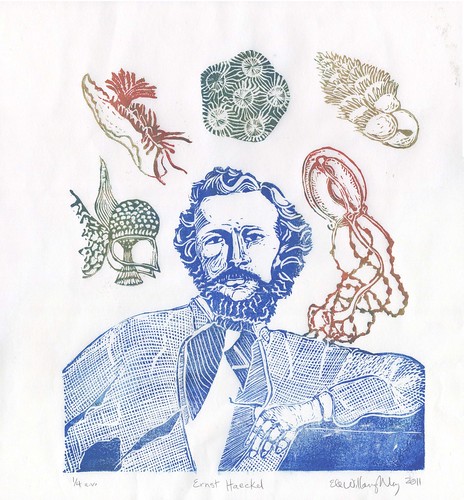 |
| Ernst Haeckel, linocut on kozo, 30.5 cm by 30.5 cm, 2011, by Ele Willoughby |
 |
| Ernst Haeckel's Artforms in Naure, 1904 can be viewed here |
His particular presentation of life*, which highlights the inherent patterns and beauty, has long been an influence on artists (myself included). Consider the rococco jellyfish chandeliers of Timothy Horn, a hommage to Haeckel's drawings. Haeckel's influence can also be seen in the surreal and imaginary zoological and botanical style drawings of Katie Scott, or the entire otherworldly visual encyclopedia in an alien language Codex Seraphinianus by Luigi Serafini. You can compare his drawings with the glass sculptures of the near contemporary Blaschka father and son, who created fabulous menageries filled with marine invertebrates as well as other creatures and botanicals and whose work likewise straddles art and science and their fertile intersection. His work lead to the incorporation of forms from nature finding their way into everything from furniture to architecture, as well as the more obvious influence on fine art and scientific illustration.
*Sadly, his deep appreciation of life in its many forms did not translate into an enlightened view of his own species. While he did make contributions to evolutionary biology, and was a great popularizer of Darwin's work in Germany, he also used a confused hodgepodge of Darwinian and Lamarkian ideas and far more speculation than a we would consider reasonable in a modern scientific sense. Some of his discredited scientific ideas were in vogue during his lifetime, and his errors should be considered within context. Most disappointing however, were his wrong-headed and repugnant social Darwinist ideas about race and his evolutionary racism which have been linked to the rise of Fascism. I've long enjoyed his extraordinary art/science and was saddened to read that he harboured such ideas, but I think it's important to avoid lionizing people, for instance for their artistic or scientific ideas, and to acknowledge their failings as well as achievements. I can admire his scientific illustration and tireless zoological investigations but still repudiate his ideas about human evolution.






No comments:
Post a Comment